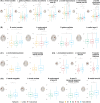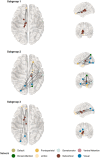Transdiagnostic profiles of behaviour and communication relate to academic and socioemotional functioning and neural white matter organisation
- PMID: 36127748
- PMCID: PMC10087495
- DOI: 10.1111/jcpp.13685
Transdiagnostic profiles of behaviour and communication relate to academic and socioemotional functioning and neural white matter organisation
Abstract
Background: Behavioural and language difficulties co-occur in multiple neurodevelopmental conditions. Our understanding of these problems has arguably been slowed by an overreliance on study designs that compare diagnostic groups and fail to capture the overlap across different neurodevelopmental disorders and the heterogeneity within them.
Methods: We recruited a large transdiagnostic cohort of children with complex needs (N = 805) to identify distinct subgroups of children with common profiles of behavioural and language strengths and difficulties. We then investigated whether and how these data-driven groupings could be distinguished from a comparison sample (N = 158) on measures of academic and socioemotional functioning and patterns of global and local white matter connectome organisation. Academic skills were assessed via standardised measures of reading and maths. Socioemotional functioning was captured by the parent-rated version of the Strengths and Difficulties Questionnaire.
Results: We identified three distinct subgroups of children, each with different levels of difficulties in structural language, pragmatic communication, and hot and cool executive functions. All three subgroups struggled with academic and socioemotional skills relative to the comparison sample, potentially representing three alternative but related developmental pathways to difficulties in these areas. The children with the weakest language skills had the most widespread difficulties with learning, whereas those with more pronounced difficulties with hot executive skills experienced the most severe difficulties in the socioemotional domain. Each data-driven subgroup could be distinguished from the comparison sample based on both shared and subgroup-unique patterns of neural white matter organisation. Children with the most pronounced deficits in language, cool executive, or hot executive function were differentiated from the comparison sample by altered connectivity in predominantly thalamocortical, temporal-parietal-occipital, and frontostriatal circuits, respectively.
Conclusions: These findings advance our understanding of commonly co-morbid behavioural and language problems and their relationship to behavioural outcomes and neurobiological substrates.
Keywords: Neurodevelopmental disorders; behaviour problems; communication; language; neural development.
© 2022 The Authors. Journal of Child Psychology and Psychiatry published by John Wiley & Sons Ltd on behalf of Association for Child and Adolescent Mental Health.
Figures




References
-
- Agelink van Rentergem, J. A. , Bathelt, J. , & Geurts, H. M. (2021). Clinical subtyping using community detection: Limited utility? 10.31234/osf.io/9vnse - DOI - PMC - PubMed
-
- Ameis, S.H. , Lerch, J.P. , Taylor, M.J. , Lee, W. , Viviano, J.D. , Pipitone, J. , … Anagnostou, E. (2016). A diffusion tensor imaging studyin children with ADHD, autism spectrum disorder, OCD, and matched controls: Distinct and non‐distinct white matter disruption and dimensional brain‐behavior relationships. American Journal of Psychiatry, 173, 1213–1222. - PubMed
-
- American Psychiatric Association. (2013). Diagnostic and statistical manual of mental disorders (DSM‐5®). Washington, DC: American Psychiatric Association, Author.
Publication types
MeSH terms
Grants and funding
LinkOut - more resources
Full Text Sources
Medical

